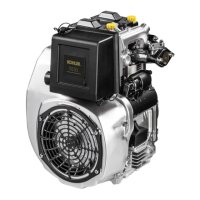- 46 -
7
85
82
83 84
I.P. (*)
22° = 44 mm 17° = 34 mm
20° = 40 mm 12° = 24 mm
Engine assembly
Injection check
1. Connect the fuel tank to the injection pumps.
2. Set the speed control lever to Max. (g.83) and the piston to
the start of compression (cylinder nr. 1 on timing gear side).
3. To eliminate the injection delay caused by the milling on
the pumping elements, bring the injection pump connection
rod (A, g.81) to a position mid-way between minimum and
maximum.
4. Fit the special tool, p.n. 00365R0940, to the delivery valve
holder (timing case side) as shown in gure 82.
5. Turn the ywheel slowly until the column of diesel fuel inside
the special tool starts to move. This indicates the start of
static injection.
For variable advance pumps, the reference mark on the ange
bell (g.85) must match the intermediate point (*) between TDC
and “IP” (start of dynamic injection) punched onto the ywheel.
On traditional pumps the static start of injection (*) is the same
as the start of dynamic injection (IP).
Should the reference mark (* or IP) fall short of the notch on the
ange bell, this indicates that injection is too advanced so that
the injection pump must be removed and then reassembled with
shims (gaskets) between the pump and the crankcase (g.84).
Should the reference mark (* or IP) fall after the TDC reference
mark, this indicates that injection is too retarded. In this case
proceed as above but this time removing shims.
Now repeat the injection timing check for all injection pumps.
Note that every 0.1mm shim inserted beneath the pump
corresponds to 2.75mm rotation of the ywheel.
Should the ywheel need changing, determine TDC and mark
the start of static and dynamic injection as shown in the table:
Version
standard
whisper quiet

